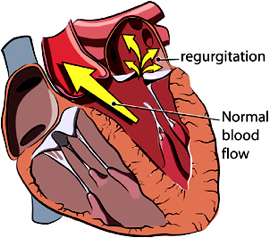Chronic Degenerative Valve Disease Stage B1
 Stage B1 Chronic Degenerative Valve Disease (CDVD). CDVD is a condition in which the valves regulating blood flow through the small chambers of the heart (atria) and the larger pumping chambers of the heart (ventricles) undergo degenerative changes and no longer create a tight seal when the ventricles contract. These changes allow blood to “regurgitate”, or leak back into the atria (see image to the right). The blood flowing across the leak creates the murmur that we hear. Some dogs have a leak only across the mitral valve on the left side of the heart, and some dogs have leaks across multiple heart valves.
Stage B1 Chronic Degenerative Valve Disease (CDVD). CDVD is a condition in which the valves regulating blood flow through the small chambers of the heart (atria) and the larger pumping chambers of the heart (ventricles) undergo degenerative changes and no longer create a tight seal when the ventricles contract. These changes allow blood to “regurgitate”, or leak back into the atria (see image to the right). The blood flowing across the leak creates the murmur that we hear. Some dogs have a leak only across the mitral valve on the left side of the heart, and some dogs have leaks across multiple heart valves.
Stage B1 refers to a patient that has developed a leak across its valve, but the condition has not yet caused enlargement, or “remodeling” of the heart. Stage B1 is therefore considered an early and mild form of the disease. Dogs can remain in Stage B1 forever. However, CDVD is a progressive disease process and can worsen over time.
If the condition progresses, the left atrial chamber can become enlarged due to the increased blood volume it is receiving. If the atrium enlarges, just like blowing up a balloon, more and more pressure will develop in the chamber. If enough pressure builds up, the pressure pushes back into the blood vessels in the lungs and causes fluid to leak into the lungs themselves, a condition termed pulmonary edema. When this happens, the patient is said to be in left sided congestive heart failure and medication is warranted. Again, some dogs with CDVD never progress to the stage of failure, and therefore medications are not necessary. But, it is wise to monitor these patients so that medical intervention can be provided if indicated. Follow-Up: It is recommended for your pet to have a physical examination and thoracic radiographs taken every 6 to 12 months. An echocardiogram should be performed every 12 months. In the event that the murmur worsens or that the heart becomes enlarged, as noted on radiographs, a follow-up echocardiogram should be performed at that time. Monitoring: Monitor your pet for an increased respiratory rate at rest. Refer to the handout outlining this technique. Also monitor for exercise intolerance, coughing, weakness, collapse or significant respiratory distress. Contact your veterinarian with any concerns. 1. photo taken from: http://www.heart-valve-surgery.com/mitral-valve-regurgitation-symptoms-leaking.php
For a printable version of the handout click here: CDVD Handout Stage B1



